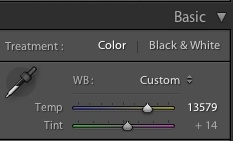Oh boy, this debate is a doozy. If you want the photography world’s version of the Hatfields vs McCoy battle, just pit a photographer who shoots JPEG against a photographer who shoots RAW.
If you aren’t familiar, the two formats are what cameras most commonly output image files in. You may have heard that some photographers swear by RAW, while others cling firmly to shooting only JPEG images. We’re not talking about the images we give clients – those will almost certainly be JPEG – no, instead we are talking about what format the camera records the photo in.
The Advantages
With all of the fuss about RAW, you’re probably wondering about what it actually provides versus JPEG images. Let’s take a look at some of the advantages.
White Balance
Have you ever gotten an image out of camera that was really orange or really blue? Sometimes the white balance setting on our camera goes crazy enough to throw the coloring of the photo off. We can adjust white balance in Lightroom, but the big advantage is that adjusting white balance in RAW images causes no loss in quality.
Exposure Adjustments
RAW files simply have more data in them, so it should come as no surprises that we can “pull out” more information. Having to tweak the exposure is going to put a strain on your files – you’ll see noise added or the quality decrease in general. In RAW, the loss of quality is less significant.
Basically…
In general, RAW is going to provide more quality and more data to work with.
The Disadvantages
There’s only two main issues with handling RAW images: file size and the need to process.
The first issue is pretty self explanatory. RAW images have more data stored in them, so they are going to be larger files. Your cards will fill quicker and you’ll find yourself fitting less images on a memory card in RAW.
When it comes to the need to process, you’re not going to be able to immediately share your RAW files to Facebook or Twitter, or even upload them to most photo printing sites. This need to process can be a big time commitment. Copying images, opening them in some software, and saving them will be a necessity.
Most cameras provide a “best of both worlds” option by allowing you to shoot duplicate copies of RAW and JPEG images. This would of course fill your memory card even quicker, but does give you quick JPEG copies to work with if need be.
Advice
I have to say that I fall firmly into the RAW camp. I feel that it allows me the most data to work with, and I’m willing to sacrifice the trade-offs of file size and a need to process.
For me, RAW is a necessity. I need to pull more data from my photos, adjust exposure, tweak white balance, and much more. I want every bit of data that I can possibly get, so RAW is a no brainer choice for me.
However, that’s not to say that there aren’t great uses for JPEG images. Sports photographers come to mind. I have several friends that shoot professional sports, and their line of work demands shooting in JPEG. For them, the advantages outweigh the benefits of the RAW format.
Sports photographers might shoot a half of a sporting event, then head to a designated media area. From there, they need to dump their images and transfer them over the Internet. This type of arrangement simply doesn’t allow for time to edit and apply retouching.
Here comes the issue that really throws people off. Yes, out of camera, JPEG looks better than RAW. This is because the camera’s “JPEG processing” basically applies editing within the camera. There is some sharpening, color adjustment, etc. RAW is going to give you a completely unprocessed images.
Yes, out of camera, JPEG looks better than RAW. This is because the camera’s “JPEG processing” basically applies editing within the camera.
Maybe the best way of looking at it is that shooting RAW is like shooting digital film. We really don’t get a finished product out of the camera when we shoot RAW, so it’s unfair to expect it to look better than a JPEG image. However, the post processing stage (hello, Lightroom!) is where we can make RAW show its full potential.
If you never venture into shooting RAW, you’re going to miss out on the power of the format. Unfortunately, too many people write off JPEG as being “good enough” and won’t learn the intricacies of processing RAW.
Wrapping Up
Regardless of the way that you choose to shoot, Lightroom accommodates and edits either file format. I put together every guide and walkthrough using my own images, and that means using RAW images. However, almost all of the guides and tips on Lightroom Love are universally applicable – although perhaps at the cost of some quality.
Lots of software can handle RAW images – Lightroom is just fantastically compatible and stays updated to handle the latest camera compatibilities. Other choices such as Photoshop, which uses Adobe Camera RAW, Phase One, and Bibble Pro will also process RAW files. Many professionals will swear by one RAW process over another. To my eyes, I like Lightroom’s RAW processing engine enough to never venture outside of it.
At the risk of sounding like a beauty pageant entrant, I have to say that there should be “world peace” among JPEG and RAW shooters. There’s room for both. However, if you’re afraid of RAW, you’re missing out on good things. Shoot JPEG by necessity, not out of laziness.
Are you a RAW shooter or a JPEG fanatic? Let’s open the comments for some friendly discussion.

